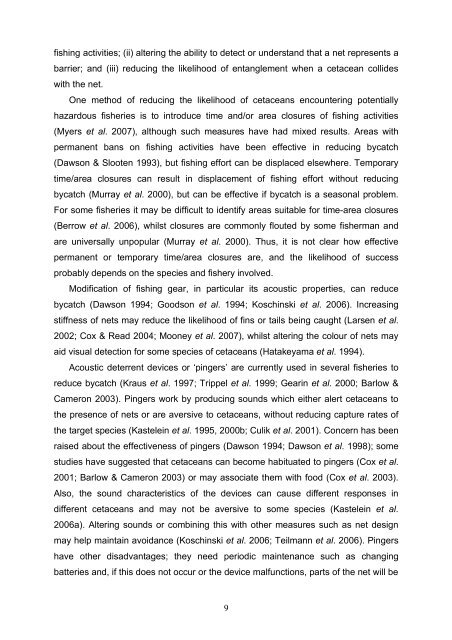The Animal Welfare Implications of Cetacean Deaths in Fisheries
The Animal Welfare Implications of Cetacean Deaths in Fisheries
The Animal Welfare Implications of Cetacean Deaths in Fisheries
Create successful ePaper yourself
Turn your PDF publications into a flip-book with our unique Google optimized e-Paper software.
fish<strong>in</strong>g activities; (ii) alter<strong>in</strong>g the ability to detect or understand that a net represents a<br />
barrier; and (iii) reduc<strong>in</strong>g the likelihood <strong>of</strong> entanglement when a cetacean collides<br />
with the net.<br />
One method <strong>of</strong> reduc<strong>in</strong>g the likelihood <strong>of</strong> cetaceans encounter<strong>in</strong>g potentially<br />
hazardous fisheries is to <strong>in</strong>troduce time and/or area closures <strong>of</strong> fish<strong>in</strong>g activities<br />
(Myers et al. 2007), although such measures have had mixed results. Areas with<br />
permanent bans on fish<strong>in</strong>g activities have been effective <strong>in</strong> reduc<strong>in</strong>g bycatch<br />
(Dawson & Slooten 1993), but fish<strong>in</strong>g effort can be displaced elsewhere. Temporary<br />
time/area closures can result <strong>in</strong> displacement <strong>of</strong> fish<strong>in</strong>g effort without reduc<strong>in</strong>g<br />
bycatch (Murray et al. 2000), but can be effective if bycatch is a seasonal problem.<br />
For some fisheries it may be difficult to identify areas suitable for time-area closures<br />
(Berrow et al. 2006), whilst closures are commonly flouted by some fisherman and<br />
are universally unpopular (Murray et al. 2000). Thus, it is not clear how effective<br />
permanent or temporary time/area closures are, and the likelihood <strong>of</strong> success<br />
probably depends on the species and fishery <strong>in</strong>volved.<br />
Modification <strong>of</strong> fish<strong>in</strong>g gear, <strong>in</strong> particular its acoustic properties, can reduce<br />
bycatch (Dawson 1994; Goodson et al. 1994; Kosch<strong>in</strong>ski et al. 2006). Increas<strong>in</strong>g<br />
stiffness <strong>of</strong> nets may reduce the likelihood <strong>of</strong> f<strong>in</strong>s or tails be<strong>in</strong>g caught (Larsen et al.<br />
2002; Cox & Read 2004; Mooney et al. 2007), whilst alter<strong>in</strong>g the colour <strong>of</strong> nets may<br />
aid visual detection for some species <strong>of</strong> cetaceans (Hatakeyama et al. 1994).<br />
Acoustic deterrent devices or ‘p<strong>in</strong>gers’ are currently used <strong>in</strong> several fisheries to<br />
reduce bycatch (Kraus et al. 1997; Trippel et al. 1999; Gear<strong>in</strong> et al. 2000; Barlow &<br />
Cameron 2003). P<strong>in</strong>gers work by produc<strong>in</strong>g sounds which either alert cetaceans to<br />
the presence <strong>of</strong> nets or are aversive to cetaceans, without reduc<strong>in</strong>g capture rates <strong>of</strong><br />
the target species (Kastele<strong>in</strong> et al. 1995, 2000b; Culik et al. 2001). Concern has been<br />
raised about the effectiveness <strong>of</strong> p<strong>in</strong>gers (Dawson 1994; Dawson et al. 1998); some<br />
studies have suggested that cetaceans can become habituated to p<strong>in</strong>gers (Cox et al.<br />
2001; Barlow & Cameron 2003) or may associate them with food (Cox et al. 2003).<br />
Also, the sound characteristics <strong>of</strong> the devices can cause different responses <strong>in</strong><br />
different cetaceans and may not be aversive to some species (Kastele<strong>in</strong> et al.<br />
2006a). Alter<strong>in</strong>g sounds or comb<strong>in</strong><strong>in</strong>g this with other measures such as net design<br />
may help ma<strong>in</strong>ta<strong>in</strong> avoidance (Kosch<strong>in</strong>ski et al. 2006; Teilmann et al. 2006). P<strong>in</strong>gers<br />
have other disadvantages; they need periodic ma<strong>in</strong>tenance such as chang<strong>in</strong>g<br />
batteries and, if this does not occur or the device malfunctions, parts <strong>of</strong> the net will be<br />
9
















